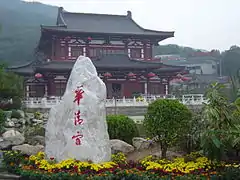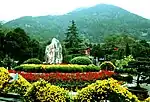| Huaqing Pool | |
|---|---|
| Huaqing Hot Springs | |
 Stone carving Huaqing Palace. | |
| Location | Mount Li, Qinling, Xi'an, Shaanxi, China |
| Coordinates | 34°21′54″N 109°12′26″E / 34.36500°N 109.20722°E |
| Huaqing Pool | |||||||||||||||||||||
|---|---|---|---|---|---|---|---|---|---|---|---|---|---|---|---|---|---|---|---|---|---|
| Traditional Chinese | 華清池 | ||||||||||||||||||||
| Simplified Chinese | 华清池 | ||||||||||||||||||||
| |||||||||||||||||||||
Huaqing Pool (华清池), or the Huaqing Hot Springs (华清宫), are a complex of hot springs located in an area characterized by mild weather and scenic views at the northern foot of Mount Li, one of the three major peaks of the Qinling. The Huaqing Hot Springs are located approximately 25 kilometers (16 mi) east of Xi'an (formerly Chang'an, the western capital of the Tang dynasty), in the province of Shaanxi, China.
History
The spring used the locally-occurring geothermal heating and features a long documented history of almost three millennia, having served as the location for several palaces built during the reigns of past Chinese dynastic rulers, including King You of the Zhou dynasty, Qin Shi Huang of the Qin dynasty, and an expanded version by Wu Han of the Han dynasty.
Under the Tang emperors Taizong and Xuanzong, with the latter had the structure rebuilt in 723 as part of the Huaqing Palace (華清宮), and is famous as the supposed scene of Xuanzong's romance with his consort Yang Guifei.[1] However, during the events associated with the An Lushan rebellion, considerable damage was done to the site. Nevertheless, the historical legacy of the Huaqing pools has received lasting commemoration, such as in the following mention of Emperor Xuanzong and Yang in Bai Juyi's poem Song of Everlasting Regret:
”春寒赐浴华清池,温泉水滑洗凝脂。
侍儿扶起娇无力,始是新承恩泽时。“
—《长恨歌》 (Chang hen ge)
On a cold spring day, he bestowed upon her the honor of bathing with him at the Huaqing pools,
The waters of the hot springs were smooth, and washed over her pale white skin.
The palace maids helped her to leave the pool, because she was too delicate and lacked strength.
This was when she began to receive the emperor's advances.
This site was also the scene of the 1936 Xi'an Incident, when Chiang Kai-shek was kidnapped by former warlord Chang Hsüeh-liang and forced to participate in a United Front with the Chinese Communist Party to oppose Japanese encroachment on China.[2]
Present
Huaqing Pool is currently an important tourist spot, classified as a AAAAA scenic area by the China National Tourism Administration.[3]
Gallery
 A view of Huaqing Palace, near Huaqing Pool
A view of Huaqing Palace, near Huaqing Pool Guifei Pond (貴妃湯)
Guifei Pond (貴妃湯) Lianhua Pond (蓮花湯)
Lianhua Pond (蓮花湯) Statue of Yang Guifei.
Statue of Yang Guifei. Huaqing Pool with artificial lotus
Huaqing Pool with artificial lotus Guifei Spring ('The Lady's Spring')
Guifei Spring ('The Lady's Spring') Feishuang Hall ('Hall of the Drifting Frost')
Feishuang Hall ('Hall of the Drifting Frost') One of the Huaqing Pool's murals
One of the Huaqing Pool's murals "Lady Yang's Pool", a reconstructed Qing version, later used by Chiang Kai-shek
"Lady Yang's Pool", a reconstructed Qing version, later used by Chiang Kai-shek Statue of Lady Yang coming out of the bath
Statue of Lady Yang coming out of the bath
References
- ↑ China: Five Thousand Years of History & Civilization (Hong Kong: City University of Hong Kong Press, 2007), p. 770.
- ↑ Ray Huang, China: A Macro History (New York: M.E. Sharpe, 1997), p. 4.
- ↑ "AAAAA Scenic Areas". China National Tourism Administration. 16 November 2008. Archived from the original on 4 April 2014. Retrieved 9 April 2011.
External links
- "The Huaqing Palace in the heyday of Tang dynasty". The missing ancient architectures. Episode 4. China Central Television. CCTV-9. (English subtitle)